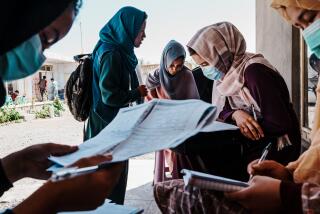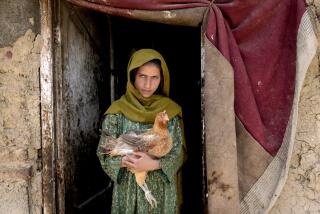Afghanistan’s slide
WITH WINTER approaching, all the indicators for Afghanistan have headed south. We are on the brink of losing Afghanistan to the resurgent Taliban and to the poverty and despair in which U.S. forces found it five years ago.
Among the many signs that the almost $12 billion the U.S. has poured into Afghanistan since 2003 for reconstruction has been neither sufficient nor well spent: Afghans will go hungry again this winter unless they receive massive food aid. Fierce fighting between NATO and Taliban forces in a wide swath of the south has conspired with drought to destroy farmers’ crops. Both the drought and the renewed warfare were predicted. The Bush administration’s failure to prevent either disaster stems from its stubborn view that Afghanistan can be fixed on the cheap.
Drought is an old enemy in Afghanistan, yet spending on water projects has lagged, as has all infrastructure work in a nation where 70% of the people are poor farmers. Without wells, ditches and modern irrigation techniques, the cycle of poverty that leaves families no choice but to grow poppies or starve will never be broken.
But in 2004, the administration invested only $23 million in water projects; it allocated $243 million to counter-narcotics and police training. Both sums, of course, are grossly inadequate. But the imbalance is telling. The administration has never matched its belated rhetorical commitment to “nation building” in Afghanistan with the troops and money that might have made that possible.
As the security situation has deteriorated, instead of redoubling its efforts to boost the Afghan standard of living as a bulwark against drug lords and Taliban radicals, the U.S. slashed aid to Afghanistan by 29% in fiscal 2006.
Without enough Western troops to suppress them, and without a central government strong enough to project power to its territories, the Taliban was bound to fill the vacuum. The United States has done little diplomatically in the last five years to establish a meaningful border between Afghanistan, which does not recognize the international border known as the Durand Line, and Pakistan, which has abandoned any effort to control the tribal areas on its side of the border.
NATO forces, which now command most of the 21,000 U.S. troops in Afghanistan, have taken over the daunting task of fighting the insurgency -- but they cannot chase the Taliban into Pakistan, reducing the effort to a cynical, though deadly, farce. Taliban forces attack, then retreat across the border into the Pakistani tribal areas to rest, rearm and treat their wounded. They return to kill more U.S. and NATO soldiers.
The continuing attacks on aid workers, contactors and government officials make it impossible to improve the standard of living in Taliban-infested provinces.
Reconstruction is stalled. The U.S. needs to renew its commitment to Afghanistan. A good first step would be to restore this year’s 29% funding cut and target the bulk of the funds to Afghanistan’s rural poor.
More to Read
Sign up for Essential California
The most important California stories and recommendations in your inbox every morning.
You may occasionally receive promotional content from the Los Angeles Times.










